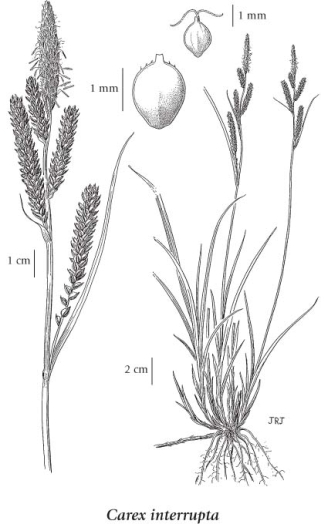green-fruited sedge (greenfruit sedge)
Cyperaceae (Sedge family)
Introduction to Vascular Plants
Introduction
Green-fruit sedge is a perennial, rhizomatous species of very restricted range in North America. It is reported only from British Columbia, Washington, Oregon and Idaho (USDA 2011). In British Columbia, it is found only in the extreme southwest of the province, in streamsides and wet places.
In his rare plants of the Fraser Valley article, Lomer (2011) says: "Until about 1996 this species was rarely collected or seen in BC. In subsequent years it has proven to be an abundant species, but one of rather restricted habitat in the Fraser Valley. It grows primarily along the eroding firm mud banks of the Fraser River and proximal tributaries from Hope to Surrey (UBC: Lomer 97-36). Rarely elsewhere such as a boggy ditch in Richmond near the Fraser (UBC: Lomer 96-20). Still rather rare overall and somewhat threatened by habitat destruction, especially dyking for riverside development. It looks somewhat like Carex lenticularis Michx., except that it is rhizomatous and grows in dense colonies, the lowest spikelet is often remotely flowered in the proximal portion (interrupted) and the perigynium is smaller." Extracted fromBotanical Electronic News #432, January 2011, with permission. A detailed description of this species is provided by Ball and Reznicek in Flora North America. A detailed discussion of the genus Carex is also provided. |
Species Information
General:
Perennial, tufted herb from long, creeping rhizomes; stems triangular, with blunt, smooth edges, 20-70 cm tall, equalling the leaves.
Leaves:
Sheaths tight, short; blades flat, well distributed along the stems, 2-5 mm wide, the lower ones reduced.
Flowers:
Spikes 3 to 10, the terminal spike with male flowers, the lower spikes 2 to 9, with female flowers, with short stalks, 3-9 cm long, cylindrical, erect; bracts subtending the spikes leaflike, sheathless, the lower ones longer than the inflorescence, the upper ones reduced.
Fruits:
Perigynia broadly elliptical, 1.5-2.1 mm long, 0.9-1.4 mm wide, brownish-green, 3-angled, the angles rounded, smooth, often ruptured by the developing achenes, the beaks short, entire; female scales egg-shaped, equalling or surpassing the perigynia, brownish-red to purplish-black, with lighter 3-nerved centres, with translucent margins; stigmas 2; achenes lens-shaped, 1.1-1.5 mm long.
Illustration

If more than one illustration is available for a species (e.g., separate illustrations were provided for two subspecies) then links to the separate images will be provided below. Note that individual subspecies or varietal illustrations are not always available.
Illustration Source: The Illustrated Flora of British Columbia
Ecology
The table below shows the species-specific information calculated from
original data (BEC database) provided by the BC Ministry of Forests and Range.
(Updated August, 2013)
| Site Information |
Value / Class |
||
|
Avg |
Min |
Max |
|
| Elevation
(metres) |
1076 | 980 | 1170 |
| Slope
Gradient (%) |
1 | 0 | 4 |
|
Aspect (degrees) |
81 | 82 | 82 |
| Soil
Moisture Regime (SMR) [0 - very xeric; 4 - mesic; 8 - hydric] |
6 | 6 | 8 |
| Modal
Nutrient Regime
Class |
D | ||
| #
of field plots species was recorded in: |
4 | ||
| Modal
BEC Zone Class |
IDF | ||
|
All BEC Zones (# of stations/zone) species was recorded in |
IDF(2), SBS(1), SWB(1) | ||
|
Source:
Klinkenberg 2013
|
|||
Habitat and Range
Streamsides and wet places in the lowland zone; rare in SW BC; S to S OR.Status Information
Synonyms
Synonyms and Alternate Names:
Carex interrupta var. distenta Kük.